Table of Contents[Hide][Show]
A nourishing homemade baby formula using safe, whole ingredients. This recipe was developed and tested by Dr. Mary Enig, a PhD Nutritionist and originally published in Nourishing Traditions cookbook in 1996. It was formulated to match breastmilk as closely as possible and is also suitable for infants. Source: Weston A. Price Foundation
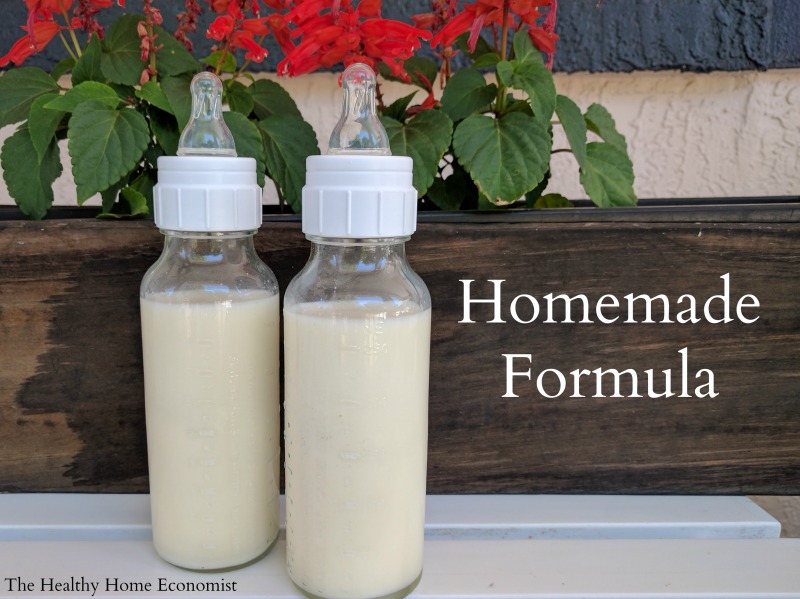
There is no doubt that breastfeeding your baby is the best option for the child’s long-term health and development. Human breastmilk from a well-nourished mother is the perfect food for baby. However, in circumstances where the child is adopted or the Mother finds herself unable to breastfeed, formula feeding becomes necessary. In those cases, homemade baby formula is best.
Using a baby formula recipe that closely matches the nutritional profile of breastmilk is a far better choice than even organic baby formula from the health food store. More on this below.
Note: Donor programs are widely available for human breastmilk. But, the diets of the donor mothers are unknown and most likely nutritionally insufficient. In addition, breastmilk banks pasteurize the donated breastmilk which destroys much of the nutritional benefit. Unless you are fortunate to have a trusted and direct donor milk source in your community, avoid this option!
Dangers of Commercial Formula
Commercial formulas are always a poor choice for a number of reasons. First of all, formula manufacturers line the cans with the chemical BPA. This substance disrupts hormone development and is a probable contributor to early puberty in girls, and ADHD, urogenital abnormalities, and other ills in boys.
The European Food Safety Authority found that canned commercial formula is a significant source of BPA for infants, exposing the child to 13mcg of BPA per kg of body weight per day! BPA-free formula cans are no better. The chemical BPS is typically used instead which is just as dangerous.
Beware that manufacturers pack even organic commercial formula like Earth’s Best in BPA cans. Worse, they use organic brown rice syrup as the primary sweetener which is known to be frequently contaminated with arsenic.
In addition, all commercial milk formulas are processed at extremely high temperatures which violently denature the fragile milk proteins, render them allergenic, and add carcinogens to the final product. Soy infant formula is the worst. Obscenely high processing temperatures not only denature the proteins but large levels of phytic acid in soy block mineral absorption by the infant. Moreover, soy-based plant estrogens disrupt the hormonal development of the baby!
It seems that for the concerned Mother who is unable to breastfeed, learning how to make baby formula at home with safe, pure ingredients is the most prudent way to go!
Why Make Homemade Formula Even if You Are Breastfeeding
In the video below, I show you how to make your own safe, healthy raw milk homemade formula for your baby.
The recipe I follow was originally published in the cookbook Nourishing Traditions in 1996 and developed by Dr. Mary Enig.
Even though I breastfed each of my children for at least 2 years, I made this exact formula for my own children when I was away for the day or the evening as pumping was not an option that worked well for me.
I even used this homemade formula for an entire day once when I had some dental work done and was advised to pump and discard for 24 hours.
As a result, even successfully breastfeeding Moms can use this wonderful homemade formula as a supplement when necessary to their own nutrient-dense breastmilk!
It is advised that even breastfeeding Mothers have the ingredients for this formula on hand for an emergency. If Mom is sick or otherwise unable to nurse, Dad can step in and make this safe alternative until Mom is back on her feet. It takes a few days to a week to gather all the ingredients together to make this formula, which is why I advise having them on hand at all times.
Homemade Most Nutritious
The image below lists the reasons why it is worth it nutritionally to make formula yourself for your precious baby!
You can order all of the required ingredients for the homemade baby formula in one package from this reputable, vetted source.
Moms who have successfully used this formula feeding your children, please post about your experience in the comments section to encourage those who are considering it and need some Mom to Mom encouragement!
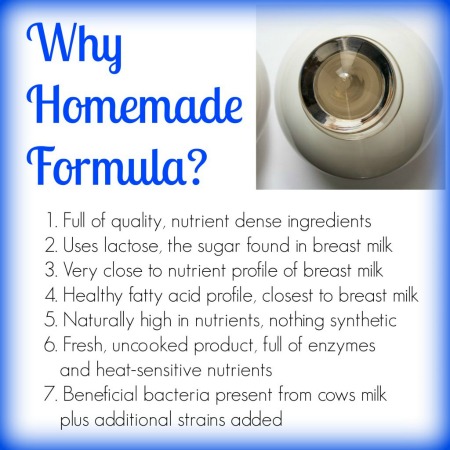
Where to Source Quality Milk
The most widely available grass-fed milk around the world is from cows. This is usually the most budget-friendly and easily sourced milk for this recipe for homemade formula.
If only goat milk is available in your area, this recipe for goat milk baby formula can be used instead. When using milk from ewes, please refer to the linked article for an adjusted recipe; one of the benefits of sheep milk is that it is higher in healthy fats than either goat or cow milk.
Camel milk formula is another option that is a particularly digestible form of dairy and growing in popularity around the world.
Alternatively, you can use low temp (vat) pasteurized, non-homogenized whole milk cultured with a piima or kefir starter. Then substitute the piima milk or kefir for the raw milk portion of the formula recipe. Cold-pressed raw milk also must be cultured before using it as it contains no probiotics.
Do NOT use ultrapasteurized (UHT) milk even if organic as it is too highly processed and extremely allergenic!
It is also best to avoid all types of powdered milk for this recipe. The factory process of making milk powder reduces nutrition considerably and denatures it, which makes it more likely baby will have an allergic reaction.
Dairy Allergy Option
If all types of dairy prove unsuitable for your baby, make this nondairy baby formula recipe instead. It uses a base of homemade bone broth as a substitute for milk. It is important not to utilize a plant-based or otherwise vegan baby formula recipe.
Avoid buying bone broth to make the dairy-free formula. Make it yourself! Manufacturers of commercial bone broth, even if authentic, may water down the end product. This is apparent if it does not gel when chilled in the refrigerator.
Many brands have toxic packaging issues as well. If you must buy it in a pinch, see my shopping guide page for vetted brands that are safe.
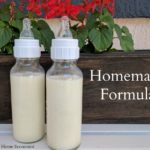
Homemade Baby Formula Recipe (for infants too)
A nourishing baby formula recipe you can make at home with safe, whole ingredients developed and tested by a PhD nutritionist to match breastmilk as closely as possible. Also suitable for infants.
Ingredients
- 2 cups raw cow milk OR organic whole milk yogurt
- 1 7/8 cups filtered water
- 1/4 cup liquid whey
- 4 Tbl lactose
- 1/4 tsp Bifidobacterium infantis powder
- 2-4 Tbl raw or pasteurized cream
- 1/2 tsp cod liver oil unflavored
- 1/4 tsp butter oil unflavored
- 1 tsp sunflower oil preferably organic
- 1 tsp extra virgin olive oil preferably organic
- 2 tsp virgin coconut oil preferably organic
- 2 tsp nutritional yeast
- 2 tsp gelatin
- 1/4 tsp acerola powder
Instructions
-
Fill a 2 cup Pyrex measuring cup with filtered water and remove 2 TBL (this will give you 1 7/8 cup water).
-
Pour about half the water into a pan and turn burner on medium.
-
Add the gelatin and lactose and let dissolve, stirring occasionally.
-
When gelatin and lactose are dissolved, remove pan from heat and add the rest of the water to cool.
-
Stir in the coconut oil and butter oil until melted.
-
Put remaining ingredients in a glass blender.
-
Add the water mixture and blend for about 3 seconds.
-
Place formula in glass baby bottles or a glass jar and refrigerate.
-
Before giving to baby, warm glass bottle in a pan of hot water or a bottle warmer. NEVER microwave baby bottles!
Recipe Video
Recipe Notes
If using raw cow milk from holstein cows, use 4 Tbl of extra cream (otherwise use 2 Tbl extra cream).
If choosing to make this homemade formula with camel milk, be sure to include 4 Tbl extra cream as camel milk is lower in cream than cow milk.
Do not use high oleic sunflower oil. Use only the brand recommended in the ingredients list which is cold pressed, organic, unrefined, and low oleic.
*Do NOT use powdered whey from the store as it is denatured. Avoid whey from making cheese as it will curdle the formula.
*Do not substitute pasteurized or powdered milk as these are heavily processed, denatured and allergenic foods.
*Do NOT use ultrapasteurized (UHT) cream. It is highly allergenic. Raw or pasteurized cream is acceptable.
*Do NOT use fish oil or krill oil instead of high vitamin cod liver oil as they do not contain any Vitamin D and very little to no Vitamin A.
Collagen powder may be substituted for the gelatin in a pinch (more on peptides in baby formula in this article).
If you are wondering where is the iron in homemade baby formula, this article provides an explanation.
If baby experiences constipation using this formula, try adding 1 tsp of molasses to each batch. This should help move things along.
How to Transition to DIY Formula
Once you’ve viewed the video, gathered the ingredients, and made your first batch, how do you feed it to your baby for the first time?
It is important not to switch all at once as this can cause gas, excessive spit-up, or an uncomfortable change in diaper habits such as constipation or overly loose stools.
Start by giving your baby three-quarters of the old formula blended with one-quarter of the homemade. Try this ratio for a day or two and see how your infant responds.
If no digestive upset or major change in diaper habits occurs, increase the amount to a 50-50 blend of old formula to homemade. Observe for another day or two as before.
If no major issues, increase once again to three-quarters homemade formula to one-quarter old formula. If baby does well on this blend for a third time, you are ready to fully transition to the homemade formula.
At any time during the transition, symptoms of intolerance emerge, back up to the previous successful blend ratio and stay there for a day or two before attempting to increase once again.
Homemade Formula FAQ
Weston Price Foundation
Feeding an Adopted Baby
Traveling Tips with Baby Formula Made at Home
Iron in Baby Formula
Collagen Peptides instead of Gelatin for Homemade Formula?


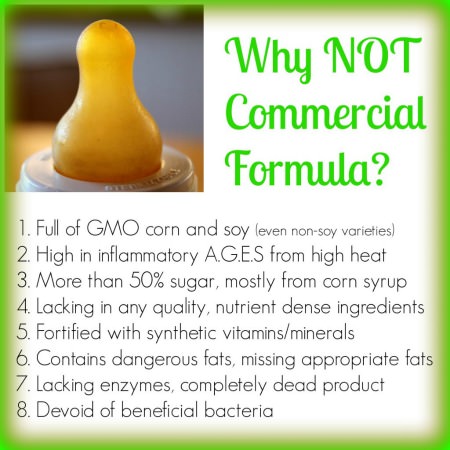
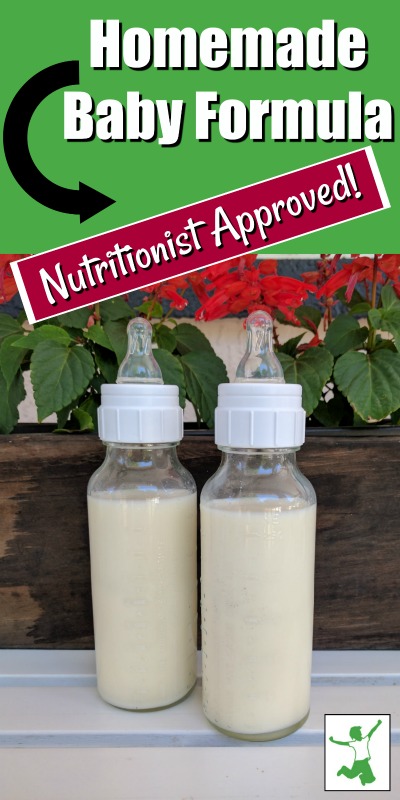






I’ve been doing it for probably four weeks now. baby is 5 months, but adjusted age is 3 months (2 months premature). He doesn’t have much spit up. I think maybe it depends on the child more than the formula. Not sure what you could do to reduce it except maybe make sure he isn’t drinking too fast or something like that. If he is having really excessive spitting up maybe he has a problem with an ingredient. But it doesn’t sound like it is excessive from your description. anyway, my experience is actually a little less spit up than before, but baby is also older so maybe that would have happened anyway.
We have been making this formula for my son for 8 weeks now (he is just over 2 months old). It is normal to have your child spit up quite a bit more with this formula. My son does also spit up sometimes a clear substance (which I suspect also is the whey) but he has had no issues aside from spit up. He is never constipated, seems to digest it well. He has about 24 oz a day right now. We only leave the formula out for an hour if he doesn’t drink all of it. We put it back in the fridge and reheat it later…seems to be no issues. Also, the website that the formula recipe comes from states to make this formula fresh daily (I don’t know how it would last a good week in the fridge without being clumpy due to the cream etc??). I suppose there is a reason they suggest it must be made everyday verses making a big batch for the week and putting it in the fridge. So, we make it daily! 🙂
I would like to make the homemade baby formula. As I don’t have access to raw milk I would like to use low temp pasteurized, non-homogenized whole milk. You suggest to culture it back to life with kefir starter. How exactly do I do that once I have the milk kefir grains which I will get from a friend?
Sarah
I wanted to thank you for posting this recipe. I was not prepared to have my baby at 34 weeks, I was not prepared to not be able to breast feed my lil girl the first month of her life and I was not prepared for the small amount of breast milk I produced the 8 months I pumped. I hated giving her store bought formula and had no clue that there was an alternative. It was heart wrenching to see other women I worked with so effortlessly produce milk for their babies. Still to this day, I feel like I let my child down… When we have our next baby I will be prepared to give him/her an alternative, if these problem happen to arise… so
thank you!
Julie
Julie, I didn’t have my children early but did have true difficulty producing milk and used formula with my first two kids. I highly recommend the book “The Breastfeeding Mother’s Guide to Making More Milk”–it is written for women who have true supply issues. With my third I was able to nurse and supplement for 4 months before switching to this recipe completely. There is an excellent chapter on grief vs. regret that helped me process my experiences. I encourage you to get a copy and read through it before your next child.
Hi Sarah,
I just started my baby on this formula, I pump and feed her breast milk but she needs one bottle of formula each day as I can’t seem to keep up!! I had tried an organic powder formula before but she hated it but didn’t have any digestive issues. With this formula she seems to spit up a lot and this morning she threw up twice about 2 hours after I gave her just 3 oz of this formula. I’m considering stopping it but I don’t want to as it seems like the healthiest thing out there..
But if she isn’t able to digest as little as 4 Oz per day I wonder if I should reduce the oils in it? Any suggestions?
Hey Sarah I just got all the my stuff together to make the formula this week. How long does it last at room temp ? Say if baby gets like two oz and then takes a nap and there is 4 oz in the bottle.. do you know how long it can be left at room temp ?
if baby has drank from the bottle, it’s only good for about an hour. the saliva gets in the bottle and starts to grow bad bacteria.
The formula wasn’t holding my baby over at all and I was told by my Pediatrician that he was eating too much, she said he’s not supposed to have over 32 oz in a 24 hours period. Well, he was having 45 +. Last night I added another 1/4 cup of whey to his formula and it is holding him over better. Is that okay to do? am I hurting him by adding that in? Thank you.
Hello! I’ve been making this formula for 7+ months and it’s great… My baby is almost 1 and will be switching to plain raw milk soon. I”m wondering what you think/know about this… I have a lot of certain ingredients (acerola, yeast, gelatin, cod liver oil), and only a lttle bit of certain ones (infantis, sunflower oil, lactose). Will it be beneficial to use up the ingredients I have? Or harmful if they’re not all included? I don’t know how they interact with each other, so I’m not sure if it’s better or not… I don’t want to just not use all these great supplements, and would rather not keep ordering because of the expense.
Thanks for your help.
Hannah, you can switch to raw milk only at 10 months, but it wouldn’t hurt to add in some of the ingredients as supplements.
I have a question about what ingredient inside the formula might be making my baby’s stomach upset. I don’t think it’s the cow’s milk, since he does okay on the similac (even though I hate giving it to him). He doesn’t spit-up, just seems to be getting tummy cramps and he is VERY fussy all of the time, but more so on the homemade formula. I want to continue giving him the homemade formula, but I don’t want him to be uncomfortable all of the time. I have heard it could be the nutritional yeast and that some are sensitive to it. Depending on what it is, what is an appropriate substitute for that ingredient? Thank you.
The nutritional yeast is only important if youre using goats milk. It is fine to just leave it out if you’re using cows milk so Id say drop it and see if it helps with the sto!mach
Okay, thank you. If it is not the nutritional yeast, what else could it be? I get stomach cramps when I take the coconut oil, but it’s a lot more that a teaspoon, and I think that is a normal transitional period. What else could it be?
Thanks so much for posting this! Breastfeeding was great while it lasted, but it didn’t last quite long enough no matter what I did 🙁 My lil one just turned 4 months and has been on this formula for a week or so now. She’s doing great on it thus far! I added a lil less gelatin because it just seemed too thick. Worked fine.
I have a question about the butter oil. I saw your recipe for homemade butter oil (ghee) Would that be a good thing to use in this formula instead of the horribly expensive commercial butter oil? Are they basically the same thing? I’m guessin the chances of you answering me after this being posted for 2 years are pretty slim, but I thought I’d have a whack at it anyway 🙂 Thanks again. You’re a Godsend
i’m no expert but i did read that butter oil and ghee are not the same thing. there is a company called nutrapro that makes high vitamin butter oil that is cheaper. one 12 ounce bottle, with 1/4 t per batch, will last for 288 batches. so i went ahead and bought it from nutrapro via amazon and I might have to buy it one more time before baby grows out of formula.